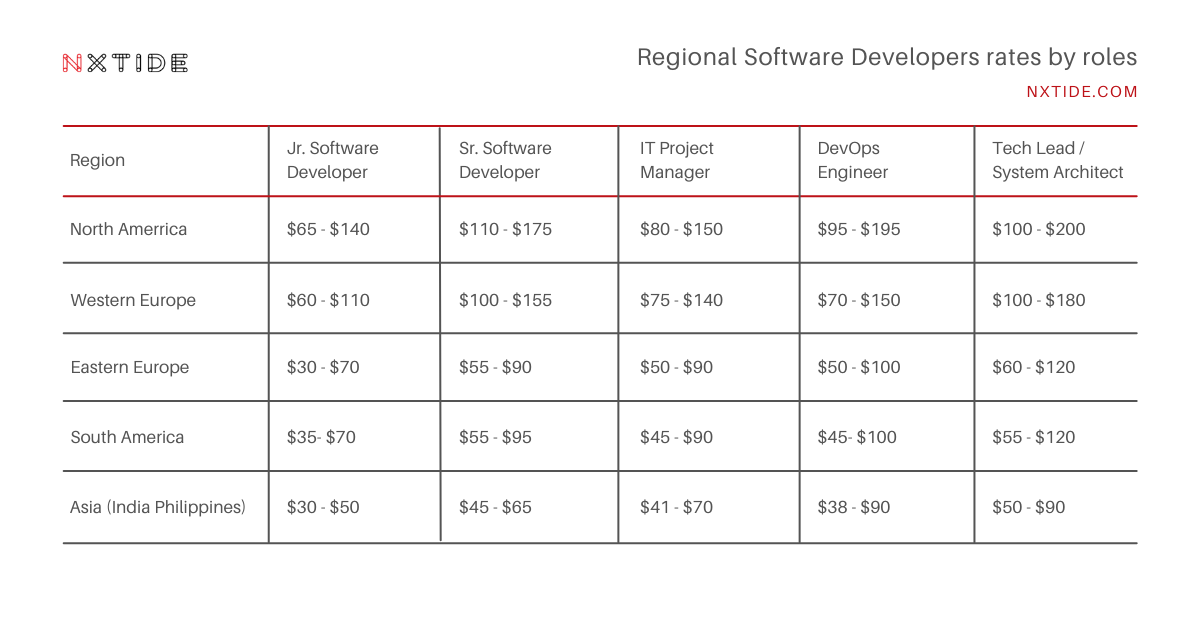How to reduce employee turnover and increase retention – insights for the CTO.

How to reduce employee turnover and increase retention – insights for the CTO.
It’s no secret that the tech industry is booming. Companies are scrambling to find qualified IT workers, and are offering top-dollar salaries and benefits to attract them. However, even with these incentives in place, employee turnover among IT workers is still high. In this article, I will discuss some strategies that CTOs can use to reduce employee turnover and boost retention among their IT staff.
The global software developers’ shortage.
The tech industry is growing at an unprecedented rate. According to the US Bureau of Labor Statistics, the number of software developer jobs is projected to grow by 24% from 2019 to 2029, much faster than the average for all occupations. This rapid growth is putting a strain on companies’ ability to find and retain qualified IT workers.
There are a number of reasons why employee turnover is high in the tech industry. First, the skills required for many IT jobs are in high demand and can be difficult to find. This shortage of qualified workers gives employees more power in the job market and makes it easier for them to switch jobs if they’re unhappy with their current situation.
Second, the tech industry is notoriously fast-paced and ever-changing. This can be stressful for employees, who may feel like they have to constantly learn new things just to keep up. This can lead to burnout, which is a major factor in employee turnover.
Finally, many tech workers are attracted to the industry because of the high salaries and generous benefits that are often offered. However, these same workers may be lured away by other companies that offer even higher salaries and better benefits.
The general damage caused by employee turnover
Turnover is expensive, and the costs are often hidden. When an employee leaves a company, it can cost the company upwards of 150% of that employee’s salary to replace them. This includes the direct costs of recruiting, hiring, and training a replacement, as well as the indirect costs associated with lost productivity and decreased morale among remaining employees. In addition, turnover can cause a loss of institutional knowledge, as departing employees take with them information about company processes and procedures that can be difficult to replace, especially in a short term.
The latest market data shows that the average employee turnover rate for IT workers is about 15%. This means that for every ten IT employees a company has, one can expect to lose within a year. To put this into perspective, if a company has 100 IT employees, it can expect to lose 15 of them each year. That’s an expensive proposition and one that CTOs need to be aware of.
The estimated cost of damage caused by employee turnover
The total cost caused by employee turnover is estimated to be $11 billion per year in the US IT sector alone. This covers the expenses of recruitment, time, and equipment. This is a huge cost for companies and one that can be reduced by taking steps to improve retention among IT employees.
We believe that these numbers are underestimated due to the fact that some employees are leaders or important parts of the whole development team. The delays caused by their absence can disrupt the development process or even turn the project into failure. In our humble opinion, we can easily multiply the damage cost value up to $100 billion per year.
Furthermore, we know that people leaving the company have a very negative impact on the overall retention rate of other employees. It is like an “avalanche/snowball effect”. The more people leave – the more are expected to leave in the next weeks and months. However those costs vary from organization to organization and it’s almost impossible to measure.
But first, let’s start with a root cause … why people leave in the first place.
Feel free to skip or look briefly through this part if you feel none of those applies to you but remembers to check the second part as this is where the true receipt is.
Lack of challenge and opportunity for growth.
Software engineers are often attracted to companies that offer them the opportunity to work on cutting-edge projects and expand their skillsets. When they feel like they’re stuck in a rut, working on the same old projects day in and day out, they become bored and dissatisfied with their jobs. As a result, they start looking for new opportunities elsewhere.
Rotating software engineers between projects might be a great way to keep them challenged and engaged. Don’t let your best people work on boring, repetitive tasks just because they can do it faster than anyone else in your company.
Best talent should be allocated to the biggest opportunities that are ahead of your company, regardless of how much training new employees might need.
The weak management team that doesn’t listen to feedback.
It’s no secret that a lot of managers are promoted not because of their people skills or management abilities, but because they’re good at their jobs. This often leads to them being out of touch with the needs and concerns of their employees. What’s more, many managers are reluctant to listen to feedback from their subordinates. They see it as a sign of weakness or an admission that they don’t know everything.

As a result, employees feel like their voices are not being heard and that their concerns are falling on deaf ears. This is a sure recipe for disaster. If your employees don’t feel like they can trust or confide in their managers, they will start looking for new opportunities elsewhere.
Make sure you have a strong, qualified management team in place. Promote people based on their ability to manage and motivate others, not just their technical skills. And most importantly, make sure your managers are open to feedback from their employees and follow the best practices in their field.
Only by listening to what your employees have to say can you hope to keep them satisfied and reduce turnover in your company.
Being disconnected from the company and co-workers.
Most software developers work remotely or in a hybrid setting, with two days at the office and three at home. Because their peers are working from home people don’t see the point of going to the office. Hence, at the end of the day, they lose sight of the company and are more prone to leaving the company.
In the ideal world, the HR team would build a system for employees to stay in touch with each other, integrate often, and thrive in a hybrid environment. Unfortunately, most of the companies failed to do so which is a great topic for another post.
Nonetheless, it’s the sole responsibility of a management team to reduce the feeling of isolation among its employees. Make sure people have enough opportunities to socialize and connect with their co-workers, even if they’re not in the same office.
Organizing regular social events, team-building activities or company-wide gatherings can help reduce the feeling of isolation among employees. If your employees feel like they’re a part of a community, they’ll be less likely to leave.


Feeling undervalued or not appreciated.
It’s easy to feel ignored after putting in a lot of hours, often after work, to complete a project. It might be some new functionality, fixing an inconvenient bug, or even coming up with a game-changing concept. “This time it will be different,” you tell yourself. They’ll sense my worth and finally give me the raise I deserve.
The Instead, you are overlooked again and again. It’s this type of culture that makes people leave their employees. Lack of feedback loops, outdated HR practices such as yearly performance reviews, or a management team that never has time for a quick one-on-one. Instead of fighting for people when they file their notice make sure your team has time for every employee.
Talking with someone is the best way to understand their situation and what can be done to help. If your employees feel like you’re invested in their success, they’ll be more likely to stick around.
Being underpaid.
It’s no secret that most people want to be paid more. In fact, a study by Glassdoor found that 60% of respondents said they would leave their job for a raise of 20% or less.
While you can’t control the market, you can make sure your employees are being paid fairly. Conduct regular salary reviews to ensure your employees are being paid in line with their experience and skills. And when it comes time to give raises, make sure you’re considering factors such as cost of living increases and inflation.
By paying your employees fairly, you can reduce the likelihood of them looking for new opportunities elsewhere.

For more information regarding nearshore software development services rates please take a look at this article: https://nxtide.com/offshore-development-center/global-offshore-software-development-rates-comparison-by-country/.
The employee retention strategies explained.
Keep in mind that there are many approaches to managing your employees and projects, so don’t feel like you have to stick to one method. The important thing is to find what works best for you and your team.
First of all – Hire the right people!
Hiring the right people is the most important thing you can do to prevent employees leave. Most Human Resources departments know that the hiring process should be designed for employee retention. If you hire the right employees from the start, you’ll save yourself a lot of time and money in the long run.
When you’re hiring, make sure you take your time and find candidates that are a good fit for your company. In addition to their skills and experience, make sure they share your company’s values and company culture.
Take a look at your team and identify top performers and future leaders.
These are the people who will help take your business to the next level. Top performers consider quality a priority over simply getting things done. They are self-directed, cool under pressure, and trusted by co-workers. They also have a positive attitude and are always looking for ways to improve. Make sure those people are well compensated for their work, their voice is heard and they have a real chance to make an impact on the company.
Now, let your top performers pick the projects they will be working on.
The assumption here is that if you correctly identified your key employees those guys will know better than anyone what are the current priorities within their fields. Just make sure they have full and unrestricted access to the information so that they can make the right decisions. Don’t micromanage them, give your top performers the space to experiment and come up with new ideas. They want to be given the freedom to work on what they think is best for the company, without being constantly supervised and managed. Most of the problems are not seen at the management level, so trust your people. You’ll be amazed at what they can achieve.
As for the rest of your department, invest in the strong management team that drives the change.
By the rest of your department, I mean like 90% of the staff working there. Yes, 90% – this is how many people will need guidance and proper management within your department. We all want to believe that every single person hired by us our co-workers is equally committed to the company’s success as we are.

Unfortunately, this is not always the case. The truth is that most people need someone to look up to, someone to guide them and help them grow both professionally and personally. A good manager will bring out the best in their team, help them solve conflicts, and grow into their roles.
Boost employee engagement
Engaged employees are more productive, have less absenteeism, and are more likely to stay with the company. There are many ways to boost employee engagement, but one of the most effective is to give employees a sense of ownership over their work.
Empowered employees feel like they can make a difference and that their work is important to the company. Make sure your employees know how their work fits into the big picture and why it matters. Encourage employees to take on new responsibilities and give them the opportunity to grow in their roles. Finally, show your appreciation for a job well done with both words and actions. A little recognition goes a long way
Offer flexible work schedules
One of the best ways to reduce employee turnover is to offer flexible work schedules. This allows employees to have a better work-life balance, which can lead to increased productivity and satisfaction. Flexible work schedules can also help attract and retain top talent. Employees who feel like they have a good work-life balance are more likely to stay with a company. There are a few different ways to offer flexible work schedules. One is to allow employees to choose their own hours. Another is to offer telecommuting options. Whatever way you choose to offer flexible work schedules, make sure you communicate the benefits to your employees. Let them know that you value their time.
Offer an option to work from home
In today’s world, more and more people are looking for the option to work from home. There are a number of reasons for this, but one of the most common is that it allows for a better work-life balance. Working from home can also lead to increased productivity and satisfaction. If you offer the option to work from home, you will be able to attract and retain top talent. There are a few different ways to offer the option to work from home. One is to allow employees to choose their own hours. Another is to offer telecommuting options. Whatever way you choose to offer the option to work from home, make sure you communicate the benefits to your employees. Let them know that you value their time.
Offer competitive salaries and benefits
If you want to improve employee turnover, you need to offer competitive salaries and benefits. This will help attract and retain top talent. There are a number of ways to determine what is considered a competitive salary. One way is to use salary surveys. Another way is to look at the salaries of similar companies in your industry. Once you have determined what a competitive salary is, you need to make sure you are offering other competitive benefits. These can include things like health insurance, retirement plans, and paid time off.
If you want to reduce employee turnover, you need to offer competitive salaries and benefits. This will help attract and retain top talent.
Create a positive work environment.
If you want to reduce employees turnover, you need to create a friendly work environment. Simply make sure your employees feel like they are part of a team. This means creating an environment where employees feel like they are valued and that their work is important to the company.
There are a few different ways to create a positive work environment. One is to make sure your employees know how their work fits into the big picture and why it matters.
Another way is to encourage employees to take on new responsibilities and give them the opportunity to grow in their roles.
Finally, show your appreciation for a job well done with both words and actions. A little recognition goes a long way.
Take care of teams’ and employee morale.
Morale is extremely important in the workplace. If morale is low, it can decrease employee retention.There are a few different ways to improve morale in the workplace. One way is to hold regular team-building activities. These can help employees feel like they are part of a team and that their work is important to the company. Another way to improve morale is to show your appreciation for a job well done. This can be done with both words and actions. Finally, make sure employees have the opportunity to take on new responsibilities and grow in their roles. This will help them feel valued and that their work is important to the company.
Set up a clear career path.
Your employees should know what they need to do to advance in their careers. If there’s no clear path for advancement, your best employees will eventually become frustrated and look for new opportunities elsewhere.
Make sure your managers are open to employee feedback
Only by listening to what your employees have to say can you hope to keep them satisfied. Make sure your managers are open to feedback and willing to make changes based on what they hear.
Encourage employees to take advantage of company resources.
Your employees should feel like they have access to the resources they need to be successful. If they don’t, they’ll eventually become frustrated and look for a job at a company that does provide them with the resources they need.
Encourage employees to take advantage of company resources.
Even though I’m a firm believer in self-organizing, cross-functional teams, there still needs to be a clear line between what each team is responsible for otherwise, things might get chaotic quickly. I’m not going to go too much into detail about what Scrum is and how it works (if you’re interested in learning more about it I suggest reading the Scrum Guide) but, in a nutshell, it’s a framework that helps teams self-organize and make decisions while providing visibility and control to the management team. However, if you have never seen properly implemented Scrum in action, don’t hesitate to hire a proper consultant that will guide you through the process. As with any framework, it can make things worse if not done correctly.
To summarize
Building a strong IT department is not a one size fits all solution, and it’s important to find what works best for you and your team. By identifying top performers you will make sure that the most important people within your company are properly compensated, engaged, and in a position to make a change. Moreover, you will distribute responsibility for success among people that still know what needs to happen for things to happen.
A strong management team will make sure that the average person within your department contributes to a company goal, and have a space to grow and a chance to get proper feedback. All in all, no one wants to be left alone.
And finally, putting your teams within proper boundaries will give you control and visibility on what works and what does not so that you will be able to make better decisions and address potential problems before it’s too late.
Thanks for reading! I hope this was helpful. 🙂 Feel free to leave a comment if you would like to see more posts like this.

Do you need help in building your Development Team?
Over our 7-year company activity we have helped many US and EU companies to successfully build Software Development Teams and Software Development Centers in a variety of locations in Poland.
Interested? – Let’s discuss your case on a call.
Marcin Dziedzic, CEO of Pragmatic Coders and NxTide.
Other related articles that might interests you:

The Top 10 ReactJS Software Development Trends for 2023 and beyond
The Top 10 ReactJS Software Development Trends for 2023 and beyond As the years have passed, ReactJS has emerged as…

Build Operate Transfer (BOT) Contract Template | Tips & Download Included
p, span { color: #000000; font-size: 19px; text-align: justify; } Build Operate Transfer (BOT) Contract Template | Tips & Download…

The Practical Guide to Hiring Software Developers.
Home The Practical Guide to Hiring Software Developers.. The software development industry is one of the most rapidly growing industries…
